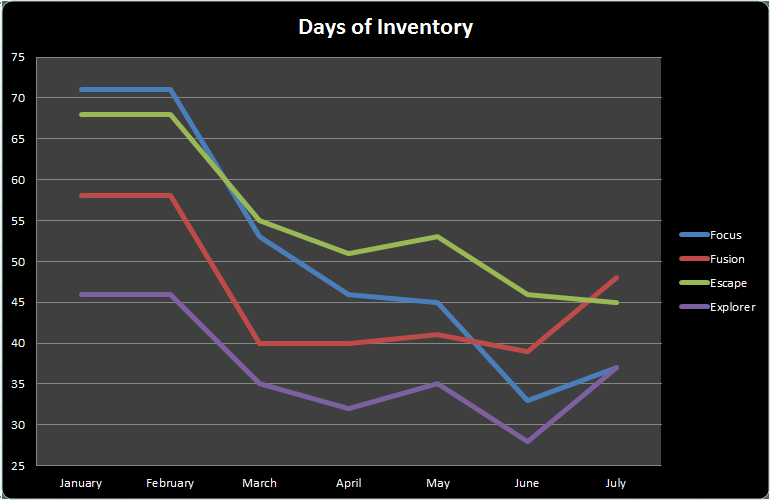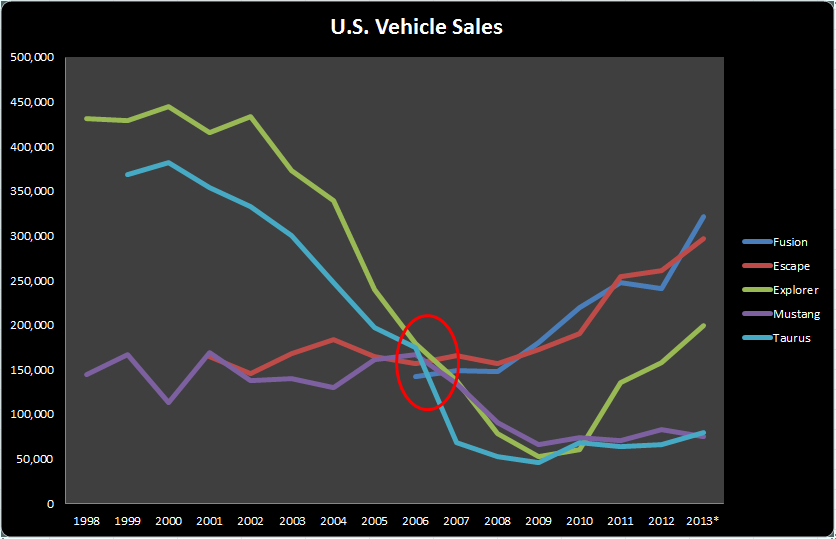
Alan Mulally with Ford's best-selling F-Series truck. Photo Credit: Ford Motor Company.
Alan Mulally is widely considered the automotive industry's top CEO and has executed his "One Ford" plan to near perfection at the Blue Oval. Those that knew Mulally from his days at Boeing, where he has been credited with helping turn the company around after the events on Sept. 11, 2001, aren't surprised to see the turnaround taking place at Ford (F 0.33%). Here's a snapshot of his one Ford plan, and further proof of the success it's driving.
When Mulally was introduced as Ford's CEO in 2006 he joked that the automaker's problems weren't as bad as Boeing's in 2001 – he just didn't realize at the time that the problems were actually worse. Ford went on to lose over $30 billion between 2006 and 2008, and was losing as much as $2,000 per vehicle due to sky-high incentives needed to sell unpopular products. That had to change, and quickly, which leads us to the first point in Mulally's strategy: aggressively restructure to operate profitably at the current demand and changing model mix.
That part of Mulally's strategy has clearly been met, and was instrumental in returning Ford to profitability way ahead of rival General Motors (GM 0.66%). Right now plants are running at very high capacity, making each one of Ford's vehicles more profitable than the last one that rolled off the assembly line.
Earlier this year, the plant that produced Ford's popular Fusion was rumored to be running over 100% capacity, with extra shifts added to try and meet demand. Ford has also added thousands of jobs in the U.S. this year to increase its production of the F-Series, Escape, and Fusion.
Ford is also balancing its inventory to match current demand, making sure that it avoids higher incentives to move excess inventory as new models arrive. In the auto industry, inventory levels in the 50-60 day range are typical; in June, Ford's inventory dipped significantly.

Graph by author, information via Automotive News DataCenter.
Ford was selling its vehicles at a quick turnaround rate, but as Fusion inventory bottomed out Ford reported that it lost some sales because of the sparse inventory. The Fusion is a good example of Mulally's second strategic point: accelerate development of new products our customers want and value.
"The domestics are getting really, really good at building small vehicles," acknowledges Fred Diaz, U.S. sales and marketing head for Nissan Division, according to Automotive News. That's a statement we couldn't have even dreamed up a decade ago, but it's today's reality. Look no further than Ford's Fusion, Focus, and Fiesta models for proof.
In fact, Ford recently announced that its Focus continues to be the world's best-selling nameplate fueled by a 153% increase in China, compared to first-quarter results last year. Mulally has definitely completely changed the Blue Oval for the better, change clearly seen in product sales as the transition was made:

Graph by author, information via Automotive News DataCenter.
When Mulally took over in 2006, the Taurus, Explorer, and Mustang gave way to the new products that consumers wanted and valued. Sales of the Fusion and Escape took off, while the remodeled and smaller version of the Explorer is making a comeback. We also can't forget that Ford's F-Series has been the best-selling truck for 36 years, and the overall best-selling vehicle for 31. It even outsold both GM's Silverado and Sierra combined over the last three years.
Bottom line
One day Mulally will have to enter retirement, and it will be a very bittersweet day for investors who watched this man accomplish something that few predicted was possible – reviving the American automaker. Fortunately for those of us who wish to see him remain CEO indefinitely, when he retires he may continue to stay on the board of directors to make sure Ford's success story continues. Until then, as losses in Europe decline and growth stories emerge overseas, there's plenty of room left in the Ford success story today.






